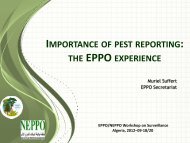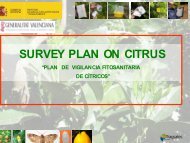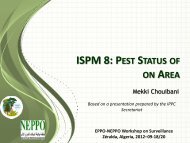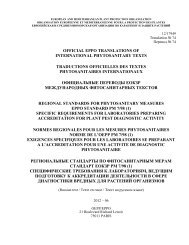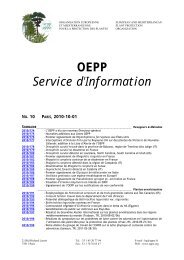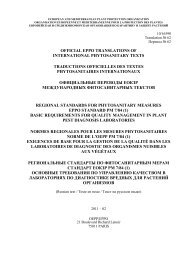EPPO Reporting Service - Lists of EPPO Standards - European and ...
EPPO Reporting Service - Lists of EPPO Standards - European and ...
EPPO Reporting Service - Lists of EPPO Standards - European and ...
Create successful ePaper yourself
Turn your PDF publications into a flip-book with our unique Google optimized e-Paper software.
2010/020 Cactaceae in Europe<br />
<strong>EPPO</strong> <strong>Reporting</strong> <strong>Service</strong> – Invasive Plants<br />
The cactus family (Cactaceae) is mainly restricted to the Americas <strong>and</strong> comprises more<br />
than 1800 species. Diversity centres are the Andean region, Central Mexico, <strong>and</strong> Brazil,<br />
where cacti colonise a wide range <strong>of</strong> dry habitats, although several species occur up to the<br />
cool-temperate regions <strong>of</strong> Patagonia <strong>and</strong> Alaska.<br />
In Europe, the cacti species which are now found outdoors in the Mediterranean region<br />
result from deliberate introductions, but in some cases these introductions have been<br />
followed by uncontrolled invasion events. Until the 19 th century, the dominant pathway <strong>of</strong><br />
entry for cacti in Europe was deliberate planting by farmers for economic reasons. For<br />
instance, Opontia ficus-indica was widely planted in the Mediterranean region for its<br />
edible fruits or for animal forage. In the last decades, deliberate planting in the wild by<br />
cacti enthusiasts for ornamental reasons has become the dominant pathway. Once planted,<br />
cacti produce seeds that are eaten <strong>and</strong> dispersed by birds <strong>and</strong> small mammals, <strong>and</strong> even by<br />
lizards <strong>and</strong> wild boars. Cacti invasions cause problems for nature conservation, especially<br />
when habitats such as rock vegetation, open dry grassl<strong>and</strong>, <strong>and</strong> Garrigue are invaded. Most<br />
climate change scenari for the Mediterranean region predict a considerable reduction in<br />
precipitation <strong>and</strong> an increase <strong>of</strong> up to 5°C <strong>of</strong> the average annual temperature by 2100. As<br />
cacti are drought resistant <strong>and</strong> tolerant to high temperatures, it can be expected that<br />
climate change will enhance the invasion success <strong>of</strong> cacti in Europe.<br />
A list <strong>of</strong> cacti species recorded in Europe has been compiled from different sources<br />
(checklists, databases, floras, atlases) for North, West, Central <strong>and</strong> South Europe. This list<br />
contains in total 26 species. All <strong>of</strong> them are confined to dry, open habitats on acid<br />
siliceous bedrocks, <strong>and</strong> mainly occur in the Mediterranean biogeographic region. By far,<br />
the most represented genus is Opuntia with 20 species. The most widespread species is<br />
Opuntia humifusa (6 countries), followed by O. ficus-indica <strong>and</strong> O. maxima (5 countries).<br />
Most species are rare <strong>and</strong> only locally established (28 invasion events) or casual (13<br />
invasion events), whereas 17 invasion events have led to wider invasions. The number <strong>of</strong><br />
invasion events over a 50-year period increased from three (1801-1851) to nine (1951-<br />
2000).<br />
The table below presents the 26 cactus species which have been recorded in Europe with<br />
their situation in each country:<br />
Species <strong>of</strong> Cactaceae Casual Locally Widely<br />
established established<br />
Austrocylindropuntia cylindrica IT<br />
Cereus peruvianus ES FR<br />
Cereus triangularis ES<br />
Cylindropuntia imbricata ES<br />
Cylindropuntia spinosior ES<br />
Hylocereus undatus ES<br />
Opuntia ammophila ES<br />
Opuntia bernichiana ES<br />
Opuntia caespitosa FR<br />
Opuntia crassa FR<br />
Opuntia dejecta IT<br />
Opuntia dillenii IT, PT ES<br />
Opuntia engelmannii ES<br />
Opuntia ficus-indica ES, FR, HR,<br />
IT, PT<br />
Opuntia huajuapensis ES<br />
Opuntia humifusa HR, DE, ES CH, FR, IT<br />
Opuntia imbricata CH, FR ES<br />
20







